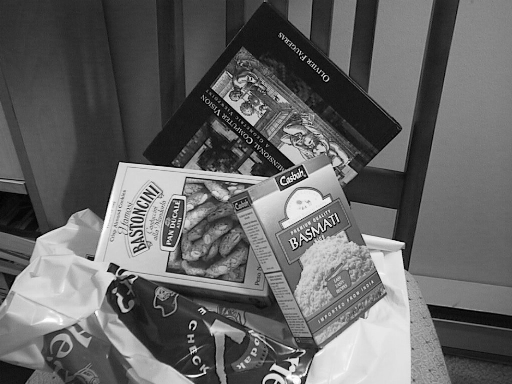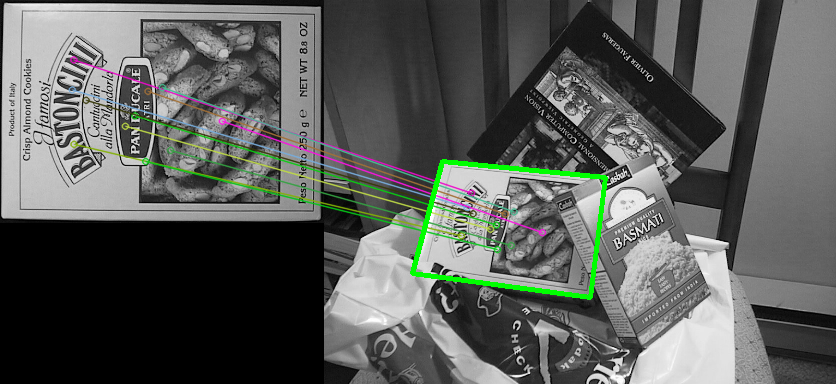AKAZEによる局所特徴量を用いて物体を検出する
OpenCVのA-KAZEで特徴量を算出し物体を検出する。
(この日本語で合ってんのか不安)
サンプルコード
検出した物体に緑の四角い枠を描くのが大変だった。
■サンプルコード
#include <windows.h>
#include <iostream>
#include <opencv2/opencv.hpp>
int main()
{
// 画像読み込み
cv::Mat source_image = cv::imread("box_in_scene.png");
if (source_image.empty()) {
std::cout << "Error." << std::endl;
return -1;
}
cv::imshow("source", source_image);
cv::Mat template_image = cv::imread("box.png");
if (template_image.empty()) {
std::cout << "Error." << std::endl;
return -1;
}
cv::imshow("template", template_image);
// AKAZE
try {
std::vector<cv::KeyPoint> source_keypoints;
std::vector<cv::KeyPoint> template_keypoints;
cv::Mat source_descriptors;
cv::Mat template_descriptors;
// cv::Ptr<cv::AKAZE> akaze = cv::AKAZE::create(cv::AKAZE::DESCRIPTOR_MLDB, 0, 3, 0.001f);
cv::Ptr<cv::AKAZE> akaze = cv::AKAZE::create();
akaze->detectAndCompute(source_image, cv::noArray(), source_keypoints, source_descriptors);
akaze->detectAndCompute(template_image, cv::noArray(), template_keypoints, template_descriptors);
// 特徴点を書き出して表示
cv::Mat source_keypoints_image;
cv::Mat template_keypoints_image;
cv::drawKeypoints(source_image, source_keypoints, source_keypoints_image, cv::Scalar::all(-1), cv::DrawMatchesFlags::DRAW_RICH_KEYPOINTS);
cv::drawKeypoints(template_image, template_keypoints, template_keypoints_image, cv::Scalar::all(-1), cv::DrawMatchesFlags::DRAW_RICH_KEYPOINTS);
cv::imshow("source keypoints", source_keypoints_image);
cv::imshow("template keypoints", template_keypoints_image);
#if 1
cv::BFMatcher matcher(cv::NORM_HAMMING);
std::vector<std::vector<cv::DMatch>> nn_matches;
matcher.knnMatch(template_descriptors, source_descriptors, nn_matches, 2); // テンプレート画像が第一引数なので注意
#else
// FLANNBASEDは精度が悪かった
cv::Ptr<cv::DescriptorMatcher> matcher = cv::DescriptorMatcher::create(cv::DescriptorMatcher::MatcherType::FLANNBASED);
std::vector<std::vector<cv::DMatch>> nn_matches;
if (template_descriptors.type() != CV_32F) {
template_descriptors.convertTo(template_descriptors, CV_32F);
}
if (source_descriptors.type() != CV_32F) {
source_descriptors.convertTo(source_descriptors, CV_32F);
}
matcher->knnMatch(template_descriptors, source_descriptors, nn_matches, 2);
#endif
std::cout << "nn_matches.size()=" << nn_matches.size() << std::endl;
// 両方の特徴量から近いところををマッチングさせる
const float ratio_thresh = 0.5f; //
std::vector<cv::DMatch> good_matches;
for (size_t i = 0; i < nn_matches.size(); i++)
{
if (nn_matches[i][0].distance < ratio_thresh * nn_matches[i][1].distance)
{
good_matches.push_back(nn_matches[i][0]);
}
}
cv::Mat matches_image;
cv::drawMatches(template_image, template_keypoints, source_image, source_keypoints, good_matches, matches_image, cv::Scalar::all(-1), cv::Scalar::all(-1), std::vector<char>(), cv::DrawMatchesFlags::NOT_DRAW_SINGLE_POINTS);
std::vector<cv::Point2f> obj;
std::vector<cv::Point2f> scene;
std::cout << "good_matches.size()=" << good_matches.size() << std::endl;
for (int i = 0; i < good_matches.size(); i++)
{
//-- Get the keypoints from the good matches
obj.push_back(template_keypoints[good_matches[i].queryIdx].pt);
scene.push_back(source_keypoints[good_matches[i].trainIdx].pt);
}
// 見つけた場所に四角を描く
if (good_matches.size() > 2) {
cv::Mat H = cv::findHomography(obj, scene, cv::RANSAC);
if (!H.empty()) {
//-- Get the corners from the image_1 ( the object to be "detected" )
std::vector<cv::Point2f> obj_corners(4);
obj_corners[0] = cv::Point2f(0.0, 0.0);
obj_corners[1] = cv::Point2f((float)template_image.cols, 0.0);
obj_corners[2] = cv::Point2f((float)template_image.cols, (float)template_image.rows);
obj_corners[3] = cv::Point2f(0.0, (float)template_image.rows);
// □で囲む
std::vector<cv::Point2f> scene_corners(4);
cv::perspectiveTransform(obj_corners, scene_corners, H);
//-- Draw lines between the corners (the mapped object in the scene - image_2 )
cv::line(matches_image, scene_corners[0] + cv::Point2f((float)template_image.cols, 0.0), scene_corners[1] + cv::Point2f((float)template_image.cols, 0.0), cv::Scalar(0, 255, 0), 4);
cv::line(matches_image, scene_corners[1] + cv::Point2f((float)template_image.cols, 0.0), scene_corners[2] + cv::Point2f((float)template_image.cols, 0.0), cv::Scalar(0, 255, 0), 4);
cv::line(matches_image, scene_corners[2] + cv::Point2f((float)template_image.cols, 0.0), scene_corners[3] + cv::Point2f((float)template_image.cols, 0.0), cv::Scalar(0, 255, 0), 4);
cv::line(matches_image, scene_corners[3] + cv::Point2f((float)template_image.cols, 0.0), scene_corners[0] + cv::Point2f((float)template_image.cols, 0.0), cv::Scalar(0, 255, 0), 4);
// cv::minAreaRectを使えばRotateRectを受け取ることができるのでそちらも検討
}
}
//-- Show detected matches
cv::imshow("Good Matches & Object detection", matches_image);
}
catch (const std::exception& e) {
std::cout << e.what() << std::endl;
}
cv::waitKey();
return 0;
}
■実行結果
nn_matches.size()=383
good_matches.size()=11
以上。


